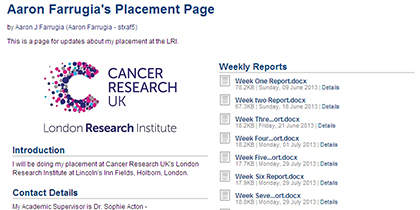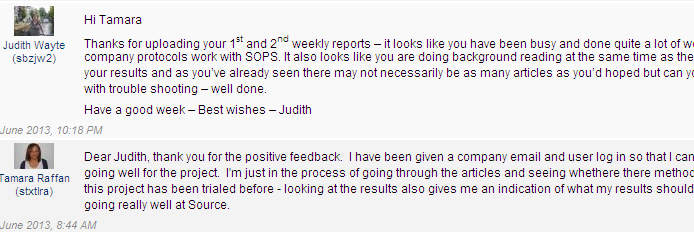
September 2, 2013, by Teaching at Nottingham
Students on placement: supporting learning with a Mahara portfolio
Judith Wayte:
“Don’t ask what the technology can do for you, rather what the pedagogy needs – Gilly Salmon; Professor of e-learning and learning technologies, University of Leicester”
“Say at the outset – it’s just a piece of software”
“I first used the first of these quotes when giving a presentation at the Assessment in the Digital Age Conference last April. The 2nd was from Martin Luck who had kindly offered to give me some feedback from the academic point of view before the conference. So yes Mahara is just a piece of software for those of you not familiar with it but it wasn’t Mahara I was first introduced to – it was project SAMSON. I can’t now remember what SAMSON stands for, but this was a JISC funded project to look at ways of improving the student placement experience and for us Mahara was going to be the project tool. We needed a tool to enhance the communication between the 3 key players in the student placement experience – the student; the university and the employer who were going to be connected but until I saw what Mahara physically looked like on the screen I had no idea and understanding of what it would be like. Fast forward 4 years and I now would call myself a Mahara user; a Mahara champion and can’t imagine not having it. One of the best descriptions of what Mahara is came from hearing Richard Windle from the School of Nursing at an e-community meeting with an excellent Venn type diagram. It was explained that Mahara can be used as a cross over between tools such as Moodle which are 100% university controlled and platforms like Facebook and Twitter which are 100% user controlled. Mahara and Pebblepad can harness some of the collaborative and sharing aspects of Facebook and Twitter into an institutionally organised piece of software.
“In meeting other colleagues I’ve heard that Mahara is very clunky; it can’t do this and it can’t do that but from our experiences it did what we wanted it to – a mechanism to improve the student placement experience.”
“I really appreciate the honest presentations at #Heastem13 about what worked. Context is very important.”
“In preparing to write this blog – I’ve been creating a list of favourites – anything I see on Twitter that I think may help – so context and honesty. We’ve been using Mahara in the School of Biosciences with a small cohort of MSc students (generally around 100) – students doing courses which involve a compulsory placement. This placement is quite short and students need to settle in quickly and we need a system to quickly identify if students are ok, settling in, are having problems and to be able to track and monitor them and so on and Mahara allows us to do that. Students can build a portfolio of checklists (H&S; induction); project outlines; Gant Charts; useful references and weekly updates with reflection and targets. This information is all in one place; we can give feedback; see our previous feedback from previous weeks and students can engage and do engage with this feedback. The students are mostly international and want to do well, please and cooperate.
“As the screengrab at the top of this page shows the students can customise their placements and make it personal. The students seem to like it as they can quite quickly create something which looks professional.
“The Mahara system allows you to leave feedback and you can see the feedback you have added previously. In addition, students can also add their comments and the students generally engage with the feedback – especially if you ask them questions as part of the feedback. The examples below clearly show the students engaging with their feedback. The 2nd also shows how the student likes the flexibility of Mahara and using it as a tool that works for her.”


“What’s the biggest thing that impacts on learners? ASSESSMENT” – Doug Belshaw
“The first year we used Mahara we did not assess it and had 95% uptake and compliance but taking context as key this is probably due to the compliant nature of our students and their desire to do well. Feedback from focus groups after the first year – the students themselves thought there should be some assessment value attached to their Mahara portfolio which we have included ever since.”
Any disappointments?
“Whilst my experience with using Mahara has been overwhelmingly positive the one disappointment has been the lack of take up on the forums. At various times I’ve encouraged students to post questions on the forums but generally have been met with a wall of silence. Rachel Scudamore gave me some encouraging and sage feedback that the forums allow those comments in a tutorial / made in speech which disappear and are forgotten to hang around and be viewed for ever so why would students post on forums? I’d like to explore this further maybe through having a forum spokesperson – channelling of comments to forums – ideas like this……….”
I tend to blog to “try to understand” – Dave Cormier
“And this, surely is the point of blogging. Otherwise it is preachyprechiness and dull” – Pat Parslow
“Being part of various university pilot projects has enabled me to learn and build on our experiences of Mahara and adapt how we use it, but making sense of how we use it and how would I explain this to others is difficult. I now can’t remember what it was like not to know how it worked; not know how to use it and this blog is supposed to help those of you just starting out. I’ve been very fortunate to be able to give presentations at Mahara 2011 and EPIC 2011 and 2013. This has also given me the opportunity to hear a range of excellent other speakers such as Kristina Hoeppner – who works for Catalyst in New Zealand and gave a fascinating talk 15 Ways to get involved with Mahara. Some of her advice has been crucial and I can’t think of a better way to give advice than select a few of Kristina’s key points:”
- Use the software – yes it can be slow; crash and so on but just use it and see how it may be useful for you. What do you want to do? Can Mahara allow you to do that?
- Ask questions – the Mahara community is great – there’s always someone else who has asked how can I do X and you can find an answer
- Write tutorials – don’t assume the students will be digitally literate – I’ve made worksheets; done whole class demos; small tutorials; made Jing videos; done telephone tutorials; Skype chats depending on the student
- Screencasts – there are always a few students who get it really quickly and produce fab looking pages quickly and easily _ using screenshots of these students’ work to demo to other students is really useful
- Answer questions – you’ll get lots!
“Academic – administration Polarisation disappearing. Third space emerging: bounded; cross boundary; unbounded; blended professionals; pracademic ” – Simon Whittemore
“So just to finish – my role in the School of Biosciences is an admin role. Before joining the university to manage placements I taught science in a secondary school for around 6 years. In Simon Whittemore’s presentation at Engage 2012 he talked about how HE roles are changing and the need for job roles which transcend the distinct academic / administration boundaries. My Head of Division in giving me this opportunity has considerably enhanced my professional development; enjoyment in my job and the opportunity to collaborate and network with colleagues from across the university who I would never have had the opportunity to engage with otherwise. Maybe there is an outlier / a pracademic in the midst of your admin team too.”
Judith Wayte
School of Biosciences
No comments yet, fill out a comment to be the first

Leave a Reply